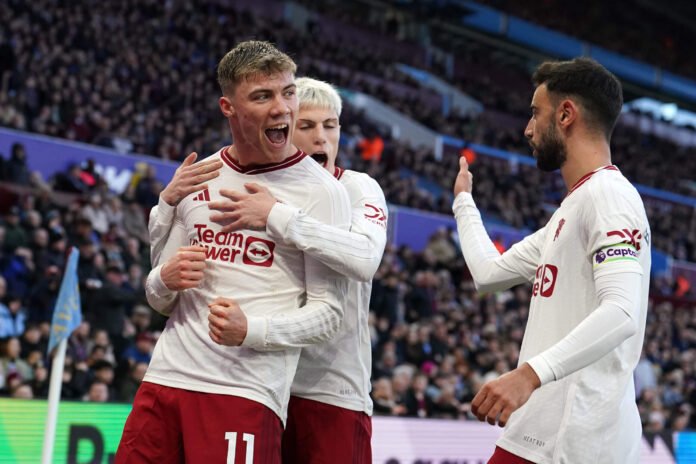The finish Rasmus Hojlund executed against Aston Villa may have looked straightforward, but to those who know him, it spoke to the change he is experiencing as Manchester United’s scoring centre-forward. It was the calmness with which Hojlund watched the ball fall from Harry Maguire’s knockdown to side-foot it between Emiliano Martinez’s legs.
That kind of clarity in a split-second pressure moment comes from the confidence he is now playing with; a surety based on finding his rhythm in the box.
Against Luton Town in November, Hojlund had his biggest miss of the season from a similar range to his goal at Villa Park. He went for power rather than placement and the ball hit goalkeeper Thomas Kaminski. Hojlund could have rushed and done the same against Martinez, but his choice of shot on Sunday showed the progress in his thinking.
It is simplistic to say goals breed goals, but Hojlund, according to people who work with him, is growing into his role leading the line for United and that sense of belonging is allowing him to trust his talent more. Becoming the second-youngest player to score in five successive Premier League games — behind Nicolas Anelka for Arsenal in 1998 — should add to that.
Nobody has scored more Premier League goals since Christmas Day than Rasmus Hojlund (5).#MUFC #AVLMNU
— Will Jeanes (@will_jeanes) February 11, 2024
Developing an understanding and trust with team-mates is also helping. The Villa goal was a training-ground routine, with Bruno Fernandes aiming his corner kick for Maguire, whose forehead is like a magnet for the ball when it’s in the air. Hojlund, with his back to Fernandes and the goal, is actually looking at Maguire as the ball is delivered before he swivels around his marker to find space inside the six-yard box. He anticipates Maguire winning his duel and is rewarded.
Rasmus Hojlund scores for the fifth game on the spin.
Manchester United lead at Villa Park.#AVFC | #MUFC | #AVLMNU
— The Athletic | Football (@TheAthleticFC) February 11, 2024
After having to make do with fortunate bounces off opponents for his first two Premier League goals, Hojlund has now had three with proper assists. As a 20-year-old fresh into life at a huge club, he started the season respectful of his team-mates and possibly too accepting when the ball failed to come his way in games. He has found his voice now, with Alejandro Garnacho on the receiving end for failing to pass at Newport County.
The sessions Erik ten Hag puts on with assistant Mitchell van der Gaag are geared towards creating moves that can be replicated on the pitch and Luke Shaw recognised Hojlund’s near-post run at Wolves to fire in the cross. Ten Hag has held one-on-one meetings to work through things, too.
Settling into the Premier League has required some time. Hojlund had a similar start to his Atalanta spell, scoring only once in his first 11 games as he adjusted from the Austrian top flight to Serie A. He went on to score nine goals in his final 21 games in Italy.
Another factor to an upturn in England is that Hojlund, who turned 21 on February 4, is reaching peak fitness given he missed pre-season and had to manage his introduction at United due to a back issue. Atalanta knew he would be sold last summer, so did not select him in any friendlies, and just before he signed for United, scans in his medical showed indications of a potential stress fracture in one of his discs. Footballers have been known to play on for years while carrying such fractures, but United wanted further tests to be sure of their investment, which will run to £72million ($91m) should all add-ons be realised.
A second examination in London showed Hojlund was essentially fine, but United delayed his debut to guard against an injury actually occurring. Since coming off the bench for his first game, at Arsenal, Hojlund has only missed two matches in all competitions, through a hamstring injury and illness, starting every Champions League game and playing close to 90 minutes in each of his past five appearances. He is dedicated to his recovery at Carrington after games, putting in long hours.
Hojlund has also benefited from the advice of a former United striker who knows what it is like to win the Premier League at the club. Robin van Persie, who was last week taking a course at United as part of his UEFA Pro Licence, had a long conversation with Hojlund at Carrington during a break from training. Hojlund’s maturity has been clear since United’s pursuit of him began in earnest and he is keen to hear from experienced players. He has close relationships with Denmark team-mate Christian Eriksen and Victor Lindelof.
Comparisons have been made with another Scandinavian in Erling Haaland and though his total of five Premier League goals this campaign is dwarfed by the Manchester City striker’s 16, their shot conversion rates are similar. Hojlund’s goals-per-shots rate is 19.2 per cent, while Haaland’s is 23.9 per cent. Liverpool’s Darwin Nunez, for example, is at 10.3 per cent. The difference is Hojlund has taken 23 shots and Haaland 67. Getting Hojlund the ball in dangerous positions more often is what Ten Hag is working on.
United were in the market for Nunez in 2022 before his price shot up to a possible £85.5m, which Liverpool agreed. Instead, United have a player who grew up supporting the club beginning to find his groove. Perhaps that is why Luca Percassi, the Atalanta chief executive, still tells John Murtough, United’s football director, that he got a bargain.
The statistics behind Hojlund tell the story of a player with high potential, albeit the pool to analyse is small.
His electric pace on the transition, clean ball-striking ability and intelligent movement in the box are all key indicators he can score goals, but the numbers that point to his sustained finishing ability have never really had a chance to settle down over a prolonged period.
Across his past two seasons of top-level football, we can take a 900-minute (or roughly, 10-game) rolling average of goals scored and non-penalty expected goals (xG) to visualise how his finishing relates to the quality of chances that fall his way.
The results do not pop out of the screen, but with Hojlund, that’s the point. A relatively steady red line indicates that generally, he has been consistent in terms of chance quality, but a blue line that dips above and below shows that Hojlund has been slightly wasteful and marginally more clinical with his chances in equal measure.
In his recent patch of form, as indicated by the sharp incline of the blue goals line, he has corrected a difficult run earlier in the season.
The two shot maps below further illustrate this swing in his fortunes; the first from his opening 14 games, failing to score despite the quality of his chances amounting to around 3.1 xG…
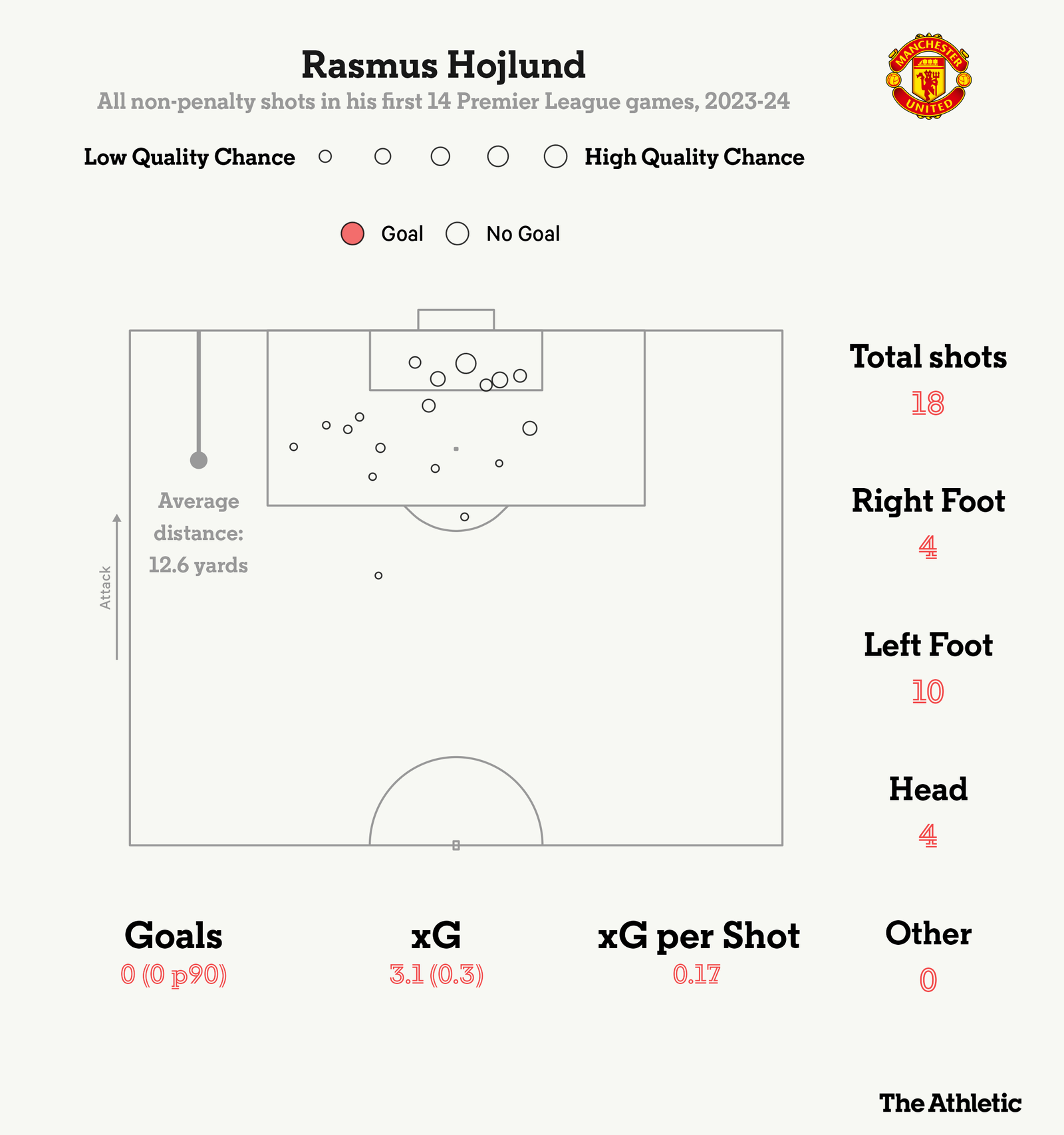
… and the second shows his most recent five games, converting five of his eight shooting opportunities, with higher-quality, closer-range opportunities falling his way.
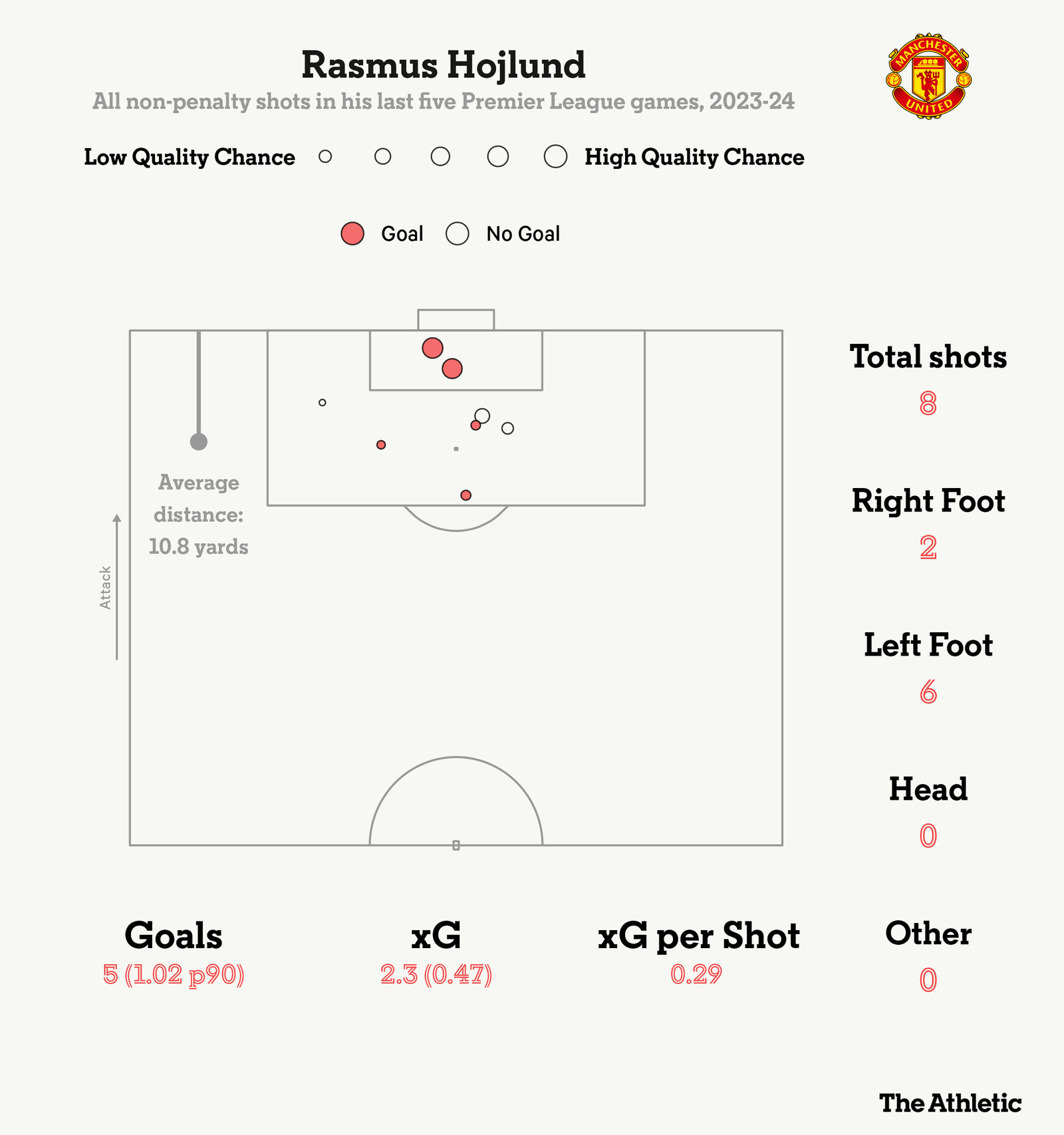
Zooming out, and since signing for Atalanta, Hojlund has scored 14 goals from 14.8 xG. Even with noticeable fluctuation, he finishes about as well as any striker should.
His past five Premier League games for United, in which all of his league goals have fallen, have featured three instinctive, close-range finishes and two flashes of inspiration. As goalscoring confidence dictates, the latter doesn’t come without the former.
Back in November for that big chance against Luton, for example, Hojlund moves well to escape Teden Mengi in the middle, first looking to drift around the back post before darting in front of the centre-back just as Marcus Rashford is about to cross.
The delivery into the middle takes a slight deflection and ends up at thigh height; Hojlund can’t get any purchase on an improvised effort and is denied from 3.4 metres.

By contrast, his latest goal at Villa comes from 3.9 metres, but this time he finds the finish.
Put simply, the more Hojlund found himself in those positions, the more likely he was to start scoring.
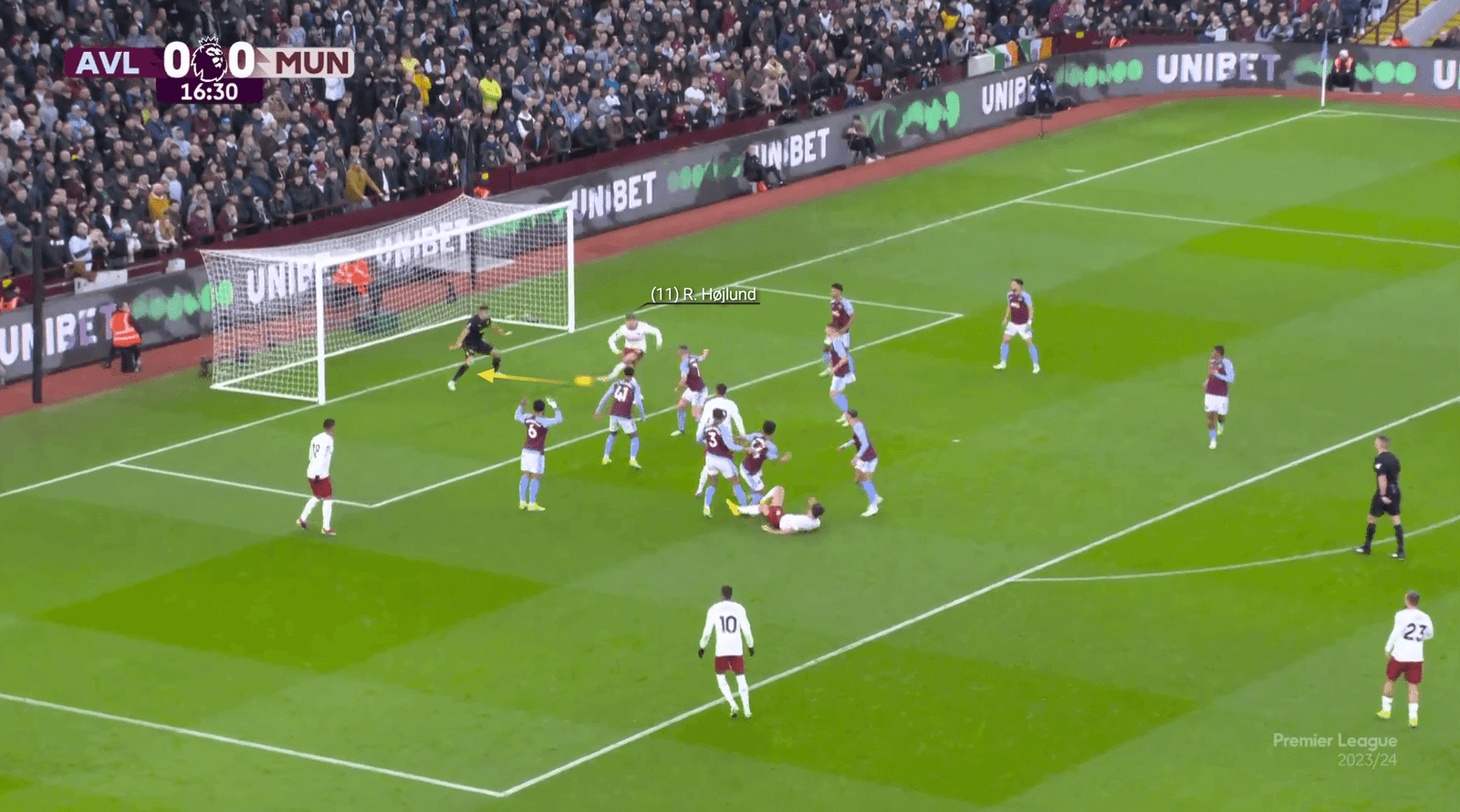
It might feel an unsatisfying conclusion, but at least the levelling out of his scoring variance has eased fears that the issue was ever skill-based.
If anything, it provides evidence United should continue to nourish Hojlund with service while he is in a rich vein of form.
As we can see from the below visual, Hojlund has not received too many valuable chances from wide playmakers this season, a lucrative source of goals at his previous club. Ademola Lookman provided three assists for the Dane last season, while Jeremie Boga and Davide Zappacosta both chipped in with crosses and cutbacks from the other side.
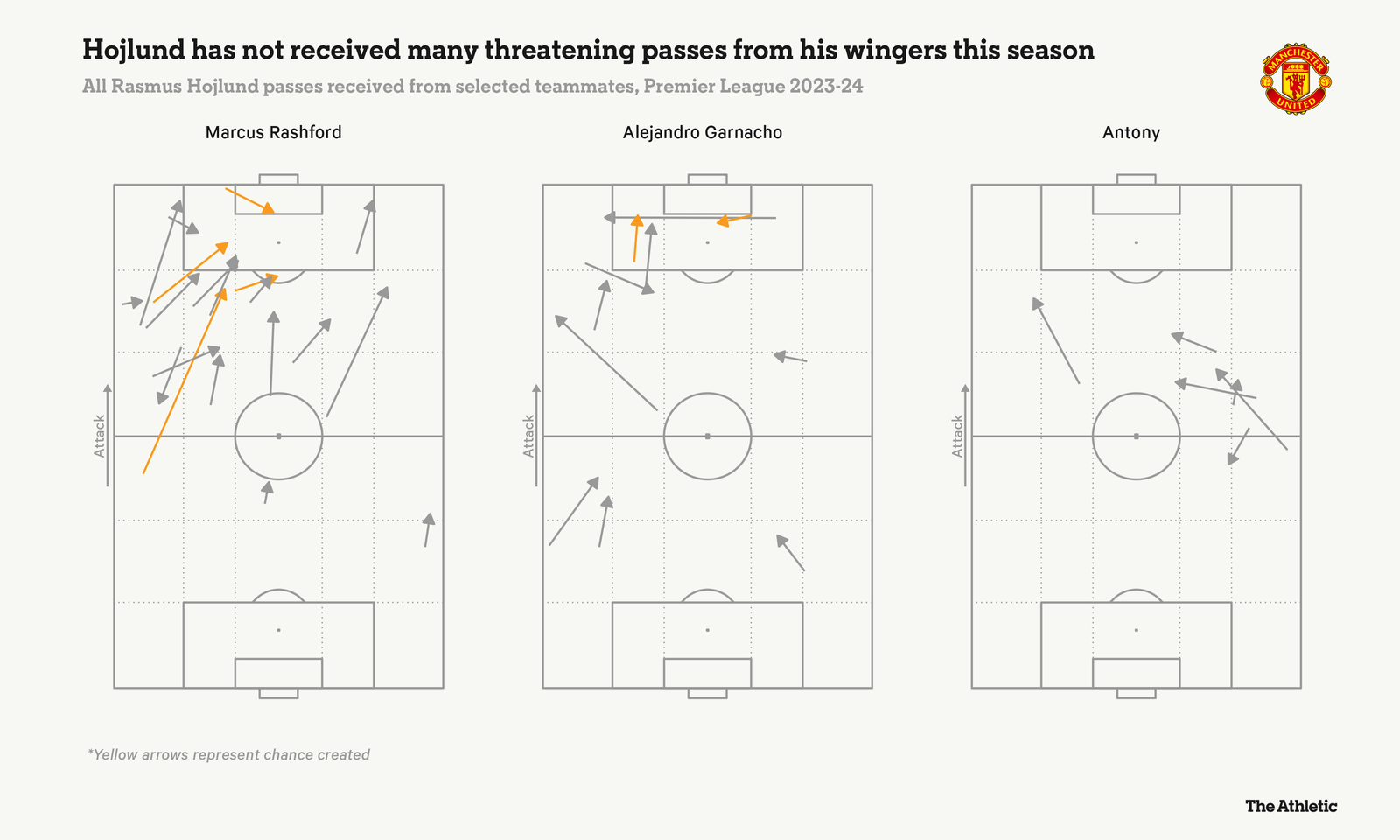
Compared to other forwards in the division, two statistics stand out. Of players with at least 900 minutes played and 25 or more shots on goal, he ranks 72nd for shots taken — averaging around 1.7 per game — but third for xG per shot, at 0.21.
In other words, Hojlund takes relatively few shots for a starting Premier League striker, but those that he does take are of a markedly high average quality.
The highs have been goal-laden, the lows so crushingly low, but Hojlund generally finishes well and moves into position even better.
Increased service will inevitably lead to increased output.
(Top photo: Martin Rickett/PA Images via Getty Images)
Read the full article here


